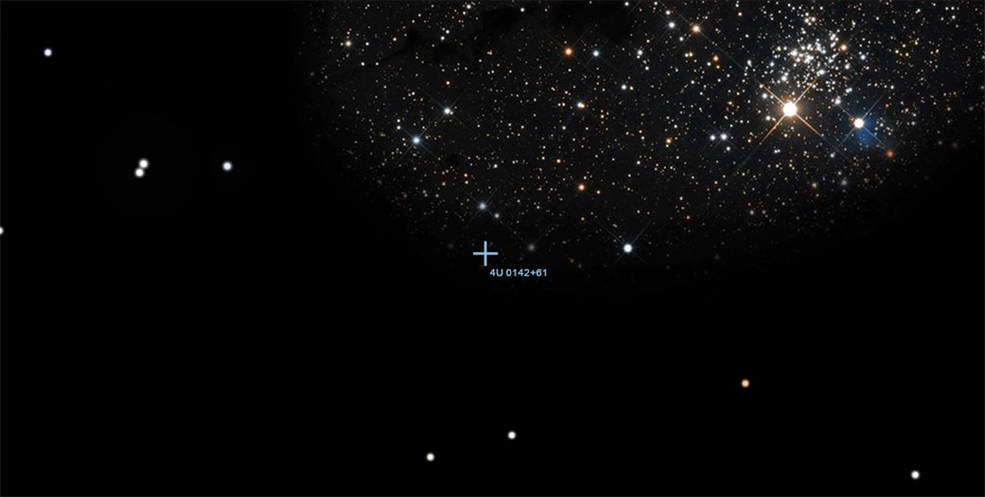Less than a year after launching, NASA’s Imaging X-ray Polarimetry Explorer’s (IXPE) observations of a neutron star have led to confirmation of what scientists have only previously theorized: magnetars have ultra-strong magnetic fields and are highly polarized.
Scientists used IXPE to observe the magnetar 4U 0142+61, a neutron star located in the Cassiopeia constellation, about 13,000 light-years away from Earth. This is the first-ever observation X-ray polarization from a magnetar, a neutron star with the most powerful magnetic fields in the universe.
Astronomers found that the neutron star likely has a solid surface and no atmosphere. This is the first time that scientists have been able to reliably conclude that a neutron star has a bare solid crust, a finding enabled by IXPE’s X-ray polarization measurements.
Polarization is a property of light that tells us about the interconnected electric and magnetic fields that make up all wavelengths of light. These fields oscillate, or vibrate, at right angles relative to the light’s path of travel. When its electric fields vibrate in a single, unified direction, we say the light is polarized.
Astronomers also found that polarization angle depends on the energy of particles of light, with high energy light at a polarization angle of 90 degrees compared to low energy light.
“We found that the angle of polarization swings by exactly 90 degrees, following what theoretical models would predict if the star had a solid crust surrounded by an external magnetosphere filled with electric currents,” said Roberto Taverna of the University of Padova, lead author of the new study in the journal Science.
Scientists were surprised to learn energy levels can affect polarization.
“Based on current theories for the magnetars, we expected to detect polarization, but no one predicted polarization would depend on energy, as we are seeing in this magnetar,” said Martin Weisskopf, a NASA emeritus scientist who led the IXPE team from the mission’s inception until spring 2022.
Additionally, the polarization at low energies indicates that the magnetic field is so unimaginably powerful that it could have turned the atmosphere around the neutron star into a solid or a liquid.
“This is a phenomenon known as magnetic condensation,” said chairman of the IXPE’s magnetar topical working group, Roberto Turolla, with the University of Padova and University College London.
It is still a subject of debate whether magnetars and other neutron stars have atmospheres.
Thanks to X-ray polarization measurements, astrophysicists are now able to check for the degree of polarization and its position angle when testing the parameters of X-ray emission models. The findings from IXPE’s observations will help X-ray astronomers to better understand the physics of extreme objects like magnetars and black holes.
“Beyond the magnetar 4U 0142+61, IXPE is being used to study a wide range of extreme X-ray sources, and lots of exciting results are coming in,” said Fabio Muleri, IXPE Italian Project Scientist from the INAF-Institute for Space Astrophysics and Planetology in Rome.
For Weisskopf, it’s clear that IXPE’s observations have been critical.
“In my mind, there can be no question that IXPE has shown that X-ray polarimetry is important and relevant to furthering our understanding of how these fascinating X-ray systems work,” he said. “Future missions will have to be cognizant of this fact.”
IXPE builds on the discoveries of NASA’s Chandra X-ray Observatory and other space telescopes by measuring the polarization of X-ray light.
Part of NASA’s Small Explorer mission series, IXPE launched on a Falcon 9 rocket from NASA’s Kennedy Space Center in Florida in December 2021. It now orbits 370 miles, or roughly 595 kilometers, above Earth’s equator. The mission is a partnership between NASA and the Italian Space Agency, with partners and science collaborators in 13 countries. Ball Aerospace, headquartered in Broomfield, Colorado, manages spacecraft operations.
By Hannah Maginot, NASA’S Marshall Space Flight Center
Molly Porter
NASA’s Marshall Space Flight Center, Huntsville, Alabama
256-424-5158
molly.a.porter@nasa.gov
Elizabeth Landau
NASA Headquarters, Washington
elandau@nasa.gov
202-358-0845

























